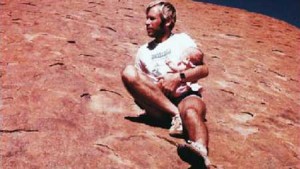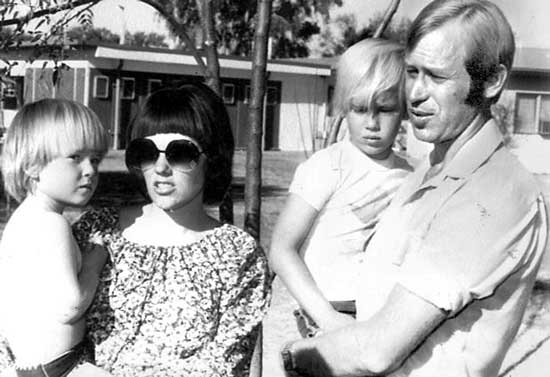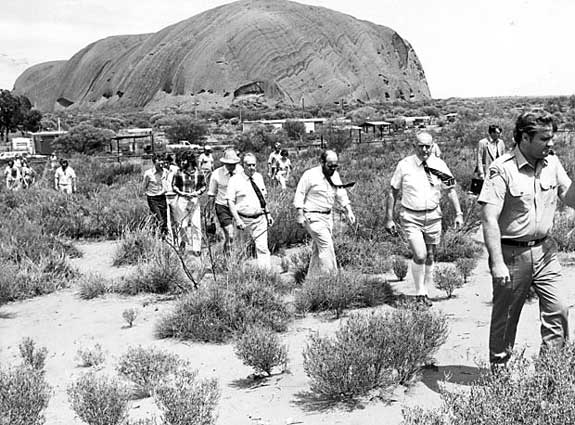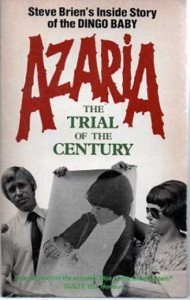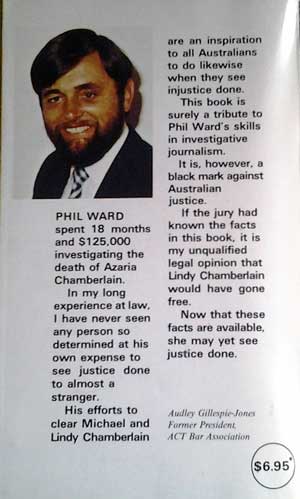Travels to Uluru
While traveling across Australia in the 1980s, I visited Ayers Rock on several occasions. The surveyor William Gosse named the sandstone monolith for the Chief Secretary of South Australia, Sir Henry Ayers, in 1873. The local people call it Uluru.
At the time, the Azaria Chamberlain disappearance at Ayers Rock was still an immense media frenzy, and the case captured my interest. Although the vast majority of Australians appeared convinced that the parents were culpable for the infant’s death, the more I learned of the details, the stranger the widespread hostility toward the Chamberlains seemed. The legal convictions of the parents in October, 1982 for the murder of their daughter seemed difficult to reconcile with key evidence. I started collecting articles and books on the case, and the more I read, the more I became convinced that the vendetta against the Chamberlains was more of a 20th century witch-hunt than an exercise in rational justice.
In 1983, I camped at the same campground where the child had disappeared; it was the last year the campground was open to visitors. In my later trips to Uluru, I camped at Yulara, which is outside of the park and quite a distance from the Rock. The Anangu people, who are the traditional owners of Uluru, are the primary caretakers and they can live inside the park.
This article is a much expanded version of a book review of Evil Angels (1985) that I wrote for the San Francisco Chronicle. Written by John Bryson, a barrister and novelist, the book is an account of the Chamberlain family tragedy in the Australian outback, the death of their infant daughter, Azaria, and its surreal legal aftermath. Bryson’s book was the basis for the acclaimed film A Cry in the Dark starring Meryl Streep and Sam O’Neill, and directed by Fred Schepisi.
In a related post, I presented some background on wild dingoes in Australia.
The Fate of Azaria Chamberlain
A dingo became one of the main players in Australia’s most notorious and bizarre legal case: the disappearance of baby Azaria Chamberlain from a tent near Ayers Rock, and the eventual trial and conviction of her parents for murder. The mother, Lindy, insisted that she saw a dingo leaving the tent with something in its mouth. The event galvanized a media frenzy in Australia and permeated the popular culture. With the release of the film A Cry in the Dark starring Meryl Streep and Sam Neill, the case became better known in the U.S. Even the Seinfield sitcom dropped a reference to the incident: in one episode Elaine snaps at an annoying mother, “The dingo took your baby!” Incredibly, the case later spawned its own Australian opera with Lindy as the heroine.
A literature professor, Christine Higgins, writing about the Chamberlain murder case cited numerous popular jokes making the rounds:
Q. What’s worse than a bull in a china shop?
A. A dingo in a maternity ward.
Q. What were two dingoes arguing about outside the tent?
A. Eat in or take-away?
Q. What event could have changed the course of history?
A. A dingo in Bethlehem.
A dingo played a key role in one of the most infamous legal cases in the world. The disappearance of 9-week-old Azaria began as a family tragedy then mutated into a murder case with no body, no weapon, and no motive. When the mother was finally charged for the baby’s murder and the father as an accessory, the incident was subjected to endless press and TV coverage.
The notoriety of the case in Australia matched American extravaganzas such as the Simpson murder trial, and foreshadowed elements in the JonBenet Ramsay case where a young girl was brutally murdered in Boulder, and police suspicion, galvanized by dubious assumptions and shaky forensics, also fell on the parents. Imagine the horror of losing a child to violence and then becoming the primary suspects. The Ramsays, however, were never charged, and the murder is unlikely to be solved.
The Chamberlains, in contrast, were charged and found guilty, and Lindy was sent to prison for the murder of her daughter. The case spawned a number of books that ranged from trashy and inept indictments of the couple to fervent advocacies of their innocence. The most elegant treatment of the case is probably John Bryson’s masterful Evil Angels.
The sand of Central Australia is the color of powdered blood, faded and bleached by a million years of sun. Near the center of the continent, Ayers Rock, the world’s largest monolith, stands a 1000 feet above the flat desert floor. The Anangu people call it Uluru, meaning ‘place of shade’; for them it is a natural cathedral, a cornerstone of their cosmology, shaped and sculpted by the primordial deeds of Dreamtime animals and ancestors.
For modern travelers in Australia, Ayers Rock has become a tourist destination that offers a glimpse of adventure and mystery to a civilization that has misplaced both.
Michael Chamberlain, a minister in the Seventh-day Adventist Church, and his wife, Lindy, and their three children made the trek to Ayers Rock in August 1980. Azaria’s two brothers, Reagan and Aidan, were aged 4 and 6.
At that time you could still camp near Uluru, and the Chamberlains pitched their tent at the campground, met their neighbors, the Lowes, and settled down to their evening meal. Dingoes were actively searching for food around the campground that night. Lindy put Azaria to sleep in their tent and started to eat her meal. A few minutes later Sally Lowe and Michael heard the short cry of a baby. Lindy, anxious, hurried to the tent in time to see a dingo emerge and disappear into the darkness. She cried, “My God. My God. The dingo’s got my baby.” A search was frantically initiated and park rangers called in to orchestrate the efforts.
Dingoes had attacked children on numerous earlier occasions but without fatalities. The head ranger, Derek Roff, had warned officials about the aggressive feeding behavior of the semi-tame dingoes and was not surprised by Azaria’s fate. He quickly located Aboriginal trackers and they followed the dingo tracks that led away from the tent. John Bryson states: “The size of the prints much impressed the tracker. ‘Big feller,’ he said. But Roff was more interested in the imprint of the bundle in the sand. The pattern put him in mind of crepe, or a knitted weave, perhaps. ‘But is it the baby?’ was what he needed to know. ‘Maybe, maybe,’ Minyintiri said. He held a palm upward to indicate the weight of the body. ‘Something like.’ Then touching the unfussed periphery of the mark with a finger, sad and gentle, he indicated something they had seen but not recognized. ‘Not move anymore,’ he said.”1.
From the beginning the unusual attitude and religious fatalism of the parents seemed to shock the press and disturb the police; public sentiment grew hostile to the overly attractive and pious couple. Rumors surfaced, one suggesting that the baby was sacrificed in a satanic ritual. The police investigating the case were skeptical of their story, many doubting that a dingo could carry off a baby. Denis Barritt, an ex-policeman, handled the first inquest. After her disappearance, some of Azaria’s clothes were found near a dingo lair, but police suspected that human hands had placed them there. But according to Bryson, Barritt realized, “it was the desert people, the rangers and the Ayers Rock police who believed a dingo was capable of the abduction. The skeptics were people in towns and cities.” In the widely televised conclusion to the first inquest, Barritt exonerated the Chamberlains and criticized the Northern Territory police for bias and incompetence. It was this stinging critique that seemed to galvanize the official obsession with the case that finally culminated in a second inquest, a murder trail and a mind-boggling guilty verdict.
Every single eyewitness supported the Chamberlains. The prosecution case was built entirely on dubious ‘scientific’ evidence. Police experts claimed to have found traces of fetal hemoglobin in the car—where Lindy allegedly slit the infant’s throat with a pair of scissors. They claimed to have located a bloody handprint on Azaria’s clothing, and to have disproved the possibility of a dingo attack. As an alternative the prosecution was forced to construct a murder scenario bordering on the absurd: the mother, accompanied by her son, Aidan, broke off a pleasant dinner conversation with strangers to go to the car, cut her baby’s throat, hide the body in a camera bag, and then later, with her husband’s assistance, bury the body and plant the clothes where they were found. No motive was offered—but perhaps they were thinking feminine churlishness.
Sally Lowe insisted at the trial that she heard Azaria cry after the time the prosecution claimed that the baby was dead. Dingo expert Les Harris was completely confident that a dingo was more than capable of snatching, carrying, and dispatching an infant of Azaria’s size. His research with dingoes showed their remarkable strength while carrying prey items, including chunks of meat far heavier than little Azaria. (Recently dingoes on Frazier Island were discovered dragging off a seven year old on a dinner date. Officials began culling the dingoes on the remarkable island. Frazier Island contains some of the purest stock of dingoes left in Australia and it seems that it is less a dingo problem than a people problem. It makes more sense to cull tourists than the dingoes.)
Surprisingly, the prosecution, feeding on public ignorance and prejudice, and pressed by governmental obsession, managed, despite their ludicrously weak case, to ram home a guilty verdict. The judge was compelled by law to give Lindy Chamberlain a life sentence. Many people remained convinced, however, of the Chamberlain’s innocence and they continued to fight their cause.
Bryson, using a novelistic style, distilled a complex story into a superbly readable book, rich in telling details and images, filled with insight, irony, and compassion. He presents a mesmerizing account of a human tragedy warped by public prejudice and an incompetent and vindictive legal system into a virtual auto-da-fe.
If Bryson’s book is the pinnacle then Steve Brien’s account Azaria: the Trial of the Century is surely the nadir. Brien, a Sydney Sun newspaper reporter, is to fair journalism what Torquemada was to religious tolerance. His 381-page account is petty, illogical, vacuous, filled with silly innuendo, and cursed by a cavalcade of clichés. Early on, while covering the case, he inveigled himself into the good graces of the naïve Chamberlains by pretending to be their friend. From the beginning he seems certain that Lindy is guilty. Why? Because, Brien repetitiously argues, they act abnormal; and even more damningly, the police don’t believe them. He seems far less interested in analyzing the facts of the case, then painting the Chamberlain’s as suspicious outsiders.
Even Lindy’s apparel is treated with suspicion as she “always dressed neatly from a seemingly never ending wardrobe….” When the Chamberlain’s act calm and detached, Brien sees this as evidence that they are just the sort of fiends who would slaughter their own baby; when the Chamberlains show distress by crying or sobbing, this only proves their guilty consciences. Occasionally, Brien makes a pretense of being open-minded but this is a façade. Describing the first legal inquest, an inquiry that appeared to exonerate the Chamberlains, Brien writes approvingly of the evidence presented against them by the police forensic experts Dr. Ken Brown and Frank Cocks: “Cock’s evidence, coupled with Brown’s, pointed the way to the real story of Azaria’s death, with scissors being the instrument of death, not a dingo’s hungry jaws.”
Nearly matching the shoddy content, Brien’s writing is ghastly. Every page sags under an avalanche of clichés: “Michael was a different kettle of fish”; “…able to regroup their forces”; “…the battle of wits raged inside…”; “…the shock troops were about to attack”; “…a chink in their armor”; “…the eagle was about to swoop, the prey knew nothing…”; “…befitting a spy novel…”; “despite our inquiries…we could still not crack the nut…” and so forth.
When we are spared clichés, we get something far worse: “Charlwood began, ‘I want to speak to you about the fact that Azaria’s throat was cut.’ His words rang out through the Chamberlain’s house like tracer bullets zipping across a battlefield.”
In describing the conspiring police who are about to swarm the Chamberlains, Brien writes: “It was imperative for the success of the operation that the ‘enemy’ be taken by complete surprise. Like generals planning an ambush that would turn the course of battle, the three men decided to hit out fast. They turned to a fourth man in the room and gave battle orders.”
Brien betrays the Chamberlain’s trust whenever he can profit by it. He publishes their private notes, naively written to him, in his newspaper. He ridicules and casts suspicion on the Chamberlain’s motives without mercy—or even common sense. Finally realizing that Brien is not their friend, they run out the back door of their own home to avoid him and his photographer. In response to their understandable anxiety, he evinces wounded outrage. No canard, innuendo, or wild speculation is too base or absurd to present as evidence against them. Brien hints that blood spatters supposedly found in a secret Aboriginal cave suggest that Azaria was a diabolical sacrifice. He notes that some believe that Azaria was dispatched with a tent peg driven into her skull before her throat was cut, and then mentions that, AHA, a tent peg had indeed gone missing. He develops this mental photo for the reader: Mum first drives the tent peg through baby’s soft little head; then, just to make sure, cuts baby’s throat in the car. Of course, the fact that there’s no evidence for this scenario doesn’t trouble Brien; it’s the juicy carnage that inspires him.
Brien treats every suspicion of the singularly incompetent Northern Territory police with reverential respect. According to police, the murder was committed in the car. So when Michael Chamberlain later had an accident in it, the police concluded that he was in reality plotting to destroy murder evidence. After a year, however, Michael still had not destroyed the car, despite ample opportunity. That might suggest his innocence–but not in Brien’s account. At one point in the book, Brien apparently becomes psychic, even seeing into Michael Chamberlain’s deepest thoughts: “There was so much on his mind, so many things he dare not speak of.” Really? Perhaps he was just depressed about the death of his baby and the endless harassment of his family by police and ruthless journalists.
Great journalists leave no stone unturned and Brien finally trots out even the Sun’s house clairvoyant to trap poor Michael. After examining a private letter from Chamberlain to Brien, she concludes, “He needs to come clean over something. There’s violence around him. He’s caught up…a web of lies and deceit, he has to admit something. He’s at a loss…something he will never get over. He has to live with it. He’ll do a penance for this. A split second decision that he made in the past will affect his life forever.” How does Brien, the sleuthing journalist, respond to this vague claptrap? “When I read her statement its accuracy sent shivers up my spine.”
Time and events have shown this book to be almost entirely false, its author an opportunistic hack. Why bother attacking it now? Primarily because it was once presented as a serious journalistic examination of the Chamberlain case. If we hold it up to the light as deceptive tabloid trash, perhaps we can detect the next fraud as it rolls off the assembly line. Because the same techniques of distortion, innuendo, and falsification used by Steve Brien to vilify grief-stricken parents can be used by a Judith Miller in the ‘prestigious’ New York Times to feed us propaganda about phantom weapon’s programs, helping to drum up support for the criminal destruction of Iraq.
If Bryson’s book is the most elegant and literary, and Brien’s account the most hackneyed and inaccurate, then Phil Ward’s book may be the most intriguing and honest. In Azaria! What the Jury were NOT Told, Ward attempted to find out what really happened the night Azaria disappeared.
Since Ward was not only a fellow Seventh-Day Adventist but knew the Chamberlains, his research was denigrated as lacking objectivity. Unable to find a book publisher, he paid to publish it himself.2. No one came to him with a Hollywood movie deal. Nonetheless, Ward is the writer who may have solved the case. After his inquiries, which elicited hostility from some Ayers Rock residents, he concluded that a semi-domesticated dingo named Ding, allegedly destroyed months earlier, had probably taken the baby from the tent and carried it to the house of a ranger. Aborigine trackers, following the tracks away from the tent, believed they were Ding’s. And Ward located two witnesses who saw Ding shot shortly after Azaria’s disappearance.
According to Ward, the remains of the baby were hidden, and the clothes placed near a dingo lair to misdirect suspicion. The cover-up spiraled out of control, involving even a local constable and his wife. No one intended to frame the Chamberlains; the locals were only masking their own culpability. The dingo, also known as Scarface, had already attacked another child and was supposed to be destroyed. Because it was a pet, however, it had been spared. At least until it savaged little Azaria.
The police always maintained that the dingo story was implausible, even impossible. However, a leading expert on dingo behavior, Les Harris, told Ward that there was nothing remarkable about the case. Everything about the alleged attack, Harris was convinced, was typical for a dingo; especially if the dingo was partly domesticated and had no fear of people.
Ward tried to take his evidence to the Chamberlain’s attorney, Stuart Tipple, right before he intended to present an appeal on behalf of the couple. Tipple refused to use the material — or even meet with Ward. Tipple’s appeal failed.
In researching Mr. Ward for this post, I learned that he ran for office in the Northern Territory in 1984, at least in part, in an attempt to challenge the Lindy Chamberlain conviction. His allegations and research also catalyzed a 1983 TV ‘investigation’, which is posted on YouTube. Initially, when I was researching Ward’s allegations, I could view the interview. Currently, it has been blocked on YouTube.
When I first read his book, I found Ward’s evidence fascinating but how accurate was his account? It seemed that someone had handled Azaria’s clothes near the dingo lairs? Who had done it? Had Ward really uncovered the authentic conspiracy? Then, by serendipity, I stumbled on a piece of corroborating evidence from another source.
An Unusual Conversation on the Death of Azaria
I met with a wildlife expert in Melbourne to discuss predators, particularly Australian pythons and elapids. He was known for his research on reptiles and was affiliated with several zoos. Over dinner, by chance, Lindy Chamberlain’s name came up. I listened and then rather diffidently mentioned that I had an interest in the case. At the time, she was still in prison and most Australians were convinced that she was indeed guilty.
The expert, whom I’ll call Bill, asked me if I thought she was guilty. Sheepishly, I admitted that I thought she was innocent and should never have been convicted. I anticipated some lampooning as a naive, ‘do-gooder’ Yank who didn’t know much about the Australian outback or the brilliance of the Northern Territory police.
Instead, Bill nodded and said, “I know for a fact she didn’t hurt that baby.”
Surprised and intrigued, I’d never heard a comment like that before. “How do you know that?”
“A dingo took her baby. A pet dingo.”
I asked him how he could say something like that.
“I know the rangers out at Ayers Rock. One of them told me that a bloody pet dingo took the baby. The truth just got covered up because no one wanted to get blamed. Nobody dreamed the crazy buggers would put her on trial!”
I thought about that. “Did anyone tell the Northern Territory police? Or go to the prosecutor?”
“A lot of time had passed…by then everyone was afraid to talk about it. They figured they’d lose their jobs and maybe end up in jail. No one dreamed they’d convict her and send her to prison!”
“Have you read Phil Ward’s book about the case?”
Bill shook his head. “Just stuff in the papers and on the telly. But I know the blokes involved so don’t need to read
I continued, “That’s exactly Phil Ward’s argument. That it was a pet dingo that got the baby and then they covered it up.”
He shrugged. “He got it right.”
“What was the name of the ranger?” I asked.
Bill hesitated, shook his head. “Oh, I can’t tell you that, mate. I can’t mention names.”
I nodded while thinking it over. “If you talk to your friend again, ask him if he’d like to clear his mind on this. I’m writing an article about the case and I’d like to interview him. He could be anonymous, keep his name out of it. He might help get the woman out of prison.”
Bill shrugged vaguely and changed the conversation back to tiger snakes and their venom.
Unfortunately, despite several entreaties, I never got my interview.
In 2004, as a bizarre followup to my conversation, a man named Frank Cole (not the man I had spoken with) confessed to shooting the dingo with Azaria in its jaws. He claimed that the baby might be buried in a yard in Melbourne. However, he was not entirely believed nor could his story be corroborated. Did ‘Bill’ know Frank Cole? Or was Cole simply someone with a lively imagination looking for a little notoriety? Bill had been matter of fact, said nothing about any Melbourne burials, and was definitely not seeking publicity.
Lindy — the Scapegoat
After four years the prosecution case against Lindy came unraveled. The German company that made the blood test that was pivotal in ‘proving’ the presence of Azaria’s blood in the car repudiated the validity of their test as employed by so-called police experts. In 1986 a British climber tragically fell (or jumped) to his death from the Rock. He was partly consumed by dingoes–who must have considered him manna from heaven.
A policeman scouring the area of the climber’s death, chanced on Azaria’s white jacket—which the prosecution had insisted at trial did not exist—buried near a dingo lair. It was covered with bits of human flesh. Soon after, in an effort by the territory government to quiet the groundswell of criticism, Lindy Chamberlain was released with a full pardon.
The murder case had transfixed and divided Australia, inspiring an immense amount of irrational loathing for Lindy Chamberlain in particular. Why did Australians scapegoat her? Psychologist David Russell argues that the desert has become an archetypal place of evil in the modern Australian psyche. The bizarre death of a child seemed to trigger fevered anxieties haunted by stalking evil, blood sacrifice, and the transformation of mothers into witches.
Neville Dawson, an Australian artist, wrestled to understand the family tragedy that erupted into a national event. Journalist Joyce Morgan notes, “Dawson…began a series of paintings about the case more than 15 years ago and has recently completed a doctorate on the subject. ‘The Great Dividing Range is aptly named in many ways because we cling rather precariously to the coastline where it’s comfortable,’ Dawson says. ‘But over there, towards the centre, we often in our literature refer to as the dead centre or the dead heart. To some extent the land, which we refer to as a mother, is a hostile mother … Lindy became a substitute for the way we vent our hostilities on the mother.’”3.
Glenda Cloughley, a Jungian analyst who lives in Canberra, argues that Lindy failed to fulfill the stereotypical behavior of a grieving mother and generated immense hostility. Cloughley views the public reaction as an outbreak of cultural madness. “She sees in Chamberlain’s scapegoating a premonition of a more recent political movement, which attempts to unify a community by finding a common enemy. ‘A truly plural society tolerates diversity and doesn’t demand that everyone conform to some idealized notion,’ she says. ‘Think about the unifying hatred of Lindy and the similarity of that to One Nation politics, which unites through prejudice and simplistic solutions that have no basis in reality. The dynamic is similar,’ Cloughley argues. But when the witch-hunt ends no psychic lesson is learned and another scapegoat is sought. ‘When someone like Lindy finally proves her innocence, the psychology just seeks another person to hang that thing on,’ she says.”4.
And then, in the strangest culmination of the entire case imaginable, there arrived the opera Lindy by Moya Henderson.5.
Does the dingo, one wonders, get an aria?
1. John Bryson, Evil Angels (Summit Books 1987).
2. Phil Ward, Azaria (Griffin Press Limited, 1984).
3. Joyce Morgan, October 2002. http://www.smh.com.au/articles/2002/10/11/1034222592161.html
4. ibid
5. Peter McCallum, October 28 2002. http://www.smh.com.au/articles/2002/10/27/1035683304577.html


